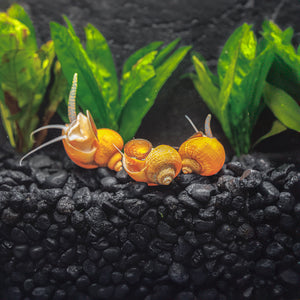Your Cart is Empty
🚚 Flat-Rate FedEx Priority Overnight — Just $26.99 (Limited-Time Special!) | FREE over $200




Gold mystery snails are a personal favorite here at Flip Aquatics. The color of the shell and snail stands out in an aquarium and is somewhat a nice yellow color. Mystery snails have become a huge part of Flip Aquatics due to their many benefits for breeding and keeping shrimp. The following reasons are why we have found these snails to be a crucial part of our shrimp tanks:
We use these beautiful snails to help keep our aquarium cycled as we add and take shrimp out of the tank to sell. They produce a fair amount of waste which helps keep beneficial bacteria. This bacteria is crucial for processing waste out of the water (also known as the nitrogen cycle).
One of the leading causes for beginner shrimp keepers to fail is overfeeding. Many hobbyists are use to feeding a lot and doing huge water changes. For shrimp, this is not the case. A smaller water change of 10% biweekly is more than enough for shrimp to thrive. Therefore, when the occasional overfeeding happens it can lead to raised ammonia level and in turn, dead shrimp.
Mystery snails have a large appetite and will gladly clean up any leftover food in an aquarium. They can actually breakdown food much quicker than shrimp through digestion. This is why we believe that snail poop is actually beneficial to a shrimp’s diet. Therefore, these snails are providing clean up and eventually natural food.
Mystery snails are from the genus Ampullariidae. They originate from South America and are extremely peaceful. In a shrimp tank, they are the gentile giant. The only downside to mystery snails is that their main diet in the wild is from feeding on dying vegetation. This means that mystery snails will not eat healthy plants. They will feed on dying plants or leaves that have fallen off the plant. These snails will thrive off of leaf matter. The snail feces is believed to be beneficial to shrimp and their overall health. There are over 120 species of snails with the Ampullariidae family.
Please note: During shipping, snails sometimes go into a hibernation-like state and may not become fully active for up to a week once acclimated to your aquarium.